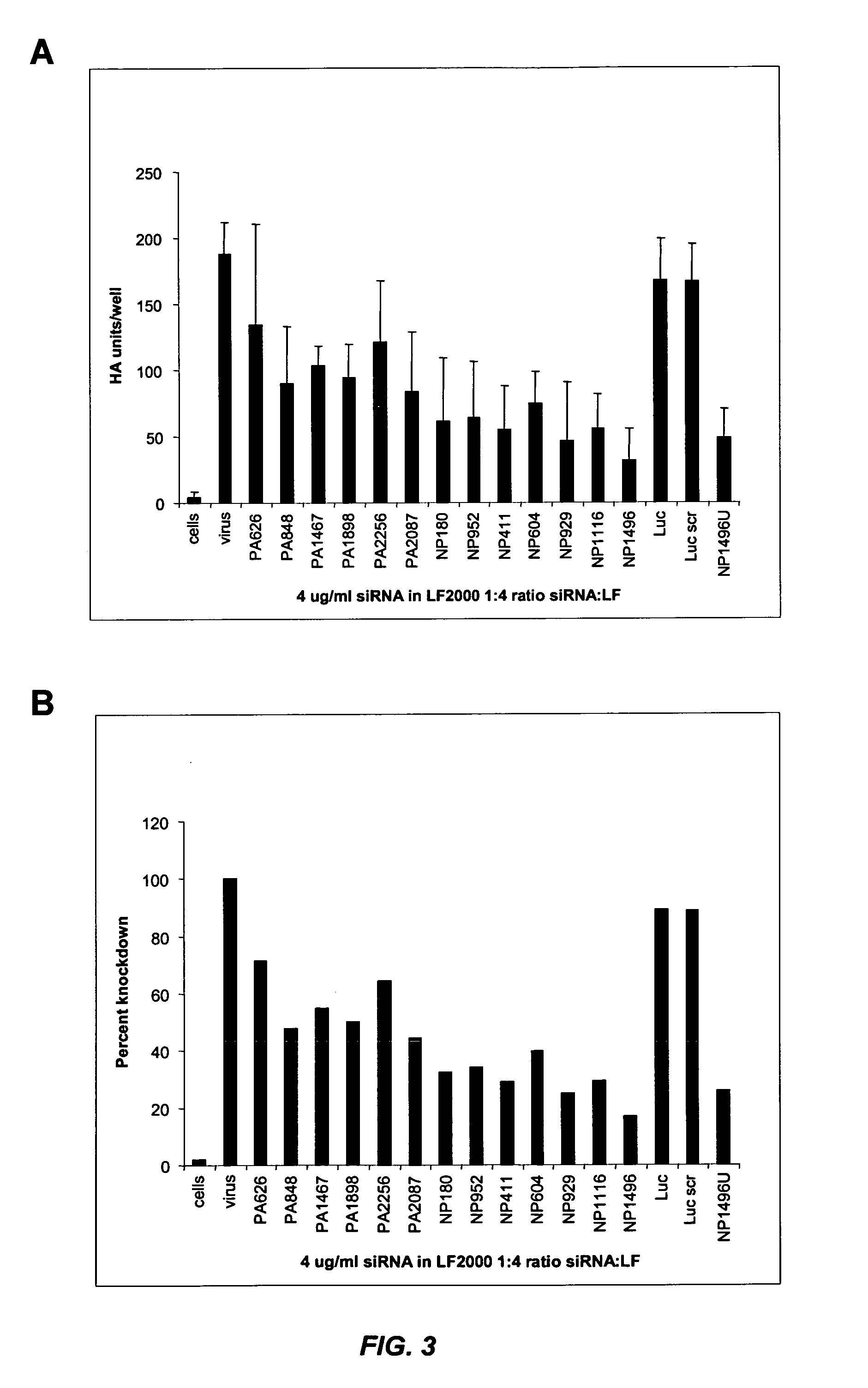siRNA silencing of influenza virus gene expression
a technology of silencing and influenza virus, applied in the field of silencing of influenza virus gene expression, can solve the problems of unpredictable occurrence of influenza pandemics, mild to severe illness, vaccine formulation, etc., and achieve the effect of downregulation of influenza virus gene sequence, and reducing the amount of influenza hemagglutinin (ha) protein
- Summary
- Abstract
- Description
- Claims
- Application Information
AI Technical Summary
Benefits of technology
Problems solved by technology
Method used
Image
Examples
example 1
Selection of Candidate Influenza siRNA
[0261] Candidate influenza sequences were identified by scanning influenza nucleocapsid protein (NP) (Genbank Accession No. AY818138) and polymerase (PA) (Genbank Accession No. AY818132) sequences to identify AA dinucleotide motifs and the 19 nucleotides 3′ of the motif. The following candidate sequences were eliminated: (1) sequences comprising a stretch of 4 or more of the same base in a row; (2) sequences comprising homopolymers of Gs; (3) sequences comprising triple base motifs (GGG, CCC, AAA, or TTT); and (4) sequences comprising stretches of 7 or more G / Cs in a row.
[0262] Reynold's Rational Design criteria was then applied to the remaining candidate sequences to identify sequences with 5 or more of the following criteria: [0263] 1. 30%-52% GC content; [0264] 2. At least 3 A / Us at positions 15-19 (sense); [0265] 3. Absence of internal repeats; [0266] 4. A at position 19 (sense); [0267] 5. A at position 3 (sense); [0268] 6. U at position 1...
example 2
In Vitro Knockdown of Influenza Virus Using siRNA Lipoplexes
[0277] This example illustrates that siRNA lipoplexes targeting influenza nucleocapsid protein (NP) or polymerase (PA) sequences can significantly reduce the cytopathic effect of influenza virus and provide substantial viral knockdown in a mammalian cell line.
[0278] The influenza virus (e.g., Influenza A H1N1) produces a cytopathic effect (CPE) in Madin-Darby Canine Kidney (MDCK) cells upon infection in the presence of trypsin. The in vitro influenza infection was performed according to the following protocol: [0279] 1. MDCK cells were seeded in 96 well plates at about 8000 cells / well (about 8×104 cells / ml) so that the cells were at about 50% density 24 hours after seeding. [0280] 2. About 24 hours later, media was changed to fresh complete media (no antibiotics) and cells were transfected with nucleic acid (e.g., siRNA) in Lipofectamine™ 2000 (LF2000). [0281] 3. About 4 hours later, complexes were removed, cells were was...
example 3
Design of Anti-Influenza siRNA with Selective Chemical Modifications
[0292] This example illustrates that minimal 2′OMe modifications at selective positions in siRNA targeting Influenza A NP and PA are sufficient to decrease the immunostimulatory properties of the siRNA while retaining RNAi activity. In particular, selective 2′OMe-uridine modifications in the sense strand of the siRNA duplex provide NP and PA siRNA with a desirable combination of silencing and non-immunostimulatory properties.
Results
[0293] Selective modifications to NP and PA siRNA retain viral knockdown activity. A panel of 2′OMe-modified NP and PA siRNA was prepared and their RNAi activity evaluated in Madin-Darby Canine Kidney (MDCK) cells. The NP siRNA duplexes used in this study are provided in Table 7. The PA siRNA duplexes used in this study are provided in Table 8. The modifications involved introducing 2′OMe-uridine at selected positions in the sense strand of the NP or PA siRNA sequence, in which the si...
PUM
| Property | Measurement | Unit |
|---|---|---|
| Temperature | aaaaa | aaaaa |
| Fraction | aaaaa | aaaaa |
| Fraction | aaaaa | aaaaa |
Abstract
Description
Claims
Application Information
 Login to View More
Login to View More - R&D
- Intellectual Property
- Life Sciences
- Materials
- Tech Scout
- Unparalleled Data Quality
- Higher Quality Content
- 60% Fewer Hallucinations
Browse by: Latest US Patents, China's latest patents, Technical Efficacy Thesaurus, Application Domain, Technology Topic, Popular Technical Reports.
© 2025 PatSnap. All rights reserved.Legal|Privacy policy|Modern Slavery Act Transparency Statement|Sitemap|About US| Contact US: help@patsnap.com



